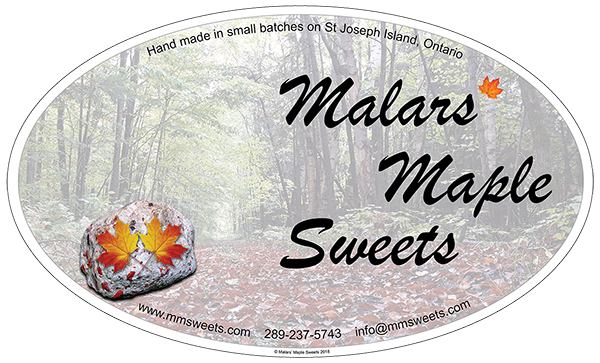Prior to the sale of our old house and the purchase of this property, we went to an event held by the Ontario Maple Syrup Producers Association. We met in Peterborough, Ontario and attended lectures (since there were so many, Dave and I attended different lectures and took notes) and went on tours of several local maple syrup producers, to see their setups, equipment and properties.
The lectures covered many topics, from research on the sizes of the actual taps and lines, to forest management, to a lecture and demonstration on making maple cream (aka "butter"), to marketing. Everything was very informative and interesting and further emphasized that we had much to learn.
When we were looking at one of the producers' lots, the forester professional who had been the one giving the lecture on forest management and who happened to be part of our tour group, said that even though the property looked beautiful, all the maples were about the same age and size.
Their canopy was blocking sunlight from the forest floor, resulting in any new growth being stunted. As an example, she pulled up a little maple tree seedling about 20 cm tall. She estimated the age of the seedling based on the number of nodes on it at ten years. It should have been many times that height.
Since trees have a given life span, and the maples there were all the same age, soon they would be producing less and less sap as they got older, and then they would be dead or dying, and the business would be done for. The solution to the immediate problem was to cull a percentage of the old trees. The canopy would then be less full, allowing more light to the forest floor, and the seedlings and saplings would be able to grow.
While removing a percentage of the old, mature, trees each year for a few years would impact the amount of sap produced in the short term, the forest would be well-maintained and the sap would increase as the younger trees reached their optimum growth for tapping, and the maple syrup operation would be sustainable for decades to come.
After having seen the producers' trees and having listened to the forester discuss the pros and cons of the trees on the producers' lots, and comparing them to our property, we decided we needed to deal with the trees in the two prime sections before we set anything up.
Our property was partially logged about 45 years ago and much of the logged areas were left to regenerate naturally. While our prime maple areas are generally quite healthy with a mixture of seedlings, saplings, and mature trees, there are also quite a number downed, old trees, some standing dead wood, and leaners and trees with health issues that need to be removed. We also have hundreds, if not thousands, of beech trees, also of mixed ages, encroaching on the maples. Once we have the problem maple and competing beech trees removed, we can expect that the remaining healthy maples will have a greatly enhanced ability to grow and the quality of the sap they produce will also be much higher. Additionally, by logging our production areas in advance of running the sap collection lines, we'll minimize the chances of damage being done by unhealthy or dead trees falling on the lines, will have much easier access through our maple bush (as there will be roads left over from the logging operation), and will have essentially a clean slate to start with.
There are a few areas of the property which we are not going to log: there are two wetlands which we want to retain for our own benefit as well as the wildlife; and, the front of the property affords us privacy and quiet, so limited or no logging will happen there.
We're looking forward to the logging operation because it'll be something totally new for us and it is the key to our being able to start building the rest of our operation, although we're trying to prepare ourselves for the noise and major disruption that all the heavy equipment will bring. Hopefully, it will only be a few weeks, and then we'll be in a position to start the next phase of building our operation.
Angi
